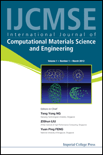
International Journal of Computational Materials Science and Engineering
Scope & Guideline
Exploring the synergy between computational techniques and material properties.
Introduction
Aims and Scopes
- Computational Modeling and Simulation:
The journal emphasizes the development and application of computational models to predict the physical and mechanical properties of materials. This includes finite element analysis (FEA), molecular dynamics simulations, and density functional theory (DFT) to understand material behavior under various conditions. - Material Characterization:
A core focus is on the characterization of novel materials, including composites, nanomaterials, and functionally graded materials (FGMs). Research often involves experimental and computational comparisons to validate theoretical predictions and enhance material performance. - Thermal and Fluid Dynamics:
The journal frequently publishes studies on thermal and fluid dynamics in materials, particularly concerning heat transfer, fluid flow in porous media, and nanofluids. This includes the exploration of thermal properties and behaviors in both theoretical and experimental contexts. - Nanotechnology and Advanced Materials:
Research on nanomaterials, including their synthesis, properties, and applications, is a significant area. The journal highlights studies that investigate the unique characteristics of nanomaterials and their potential in various engineering applications. - Interdisciplinary Applications:
The journal promotes interdisciplinary research that connects materials science with fields such as mechanical engineering, civil engineering, and biomedical applications. This includes studies on the application of materials in real-world scenarios, such as structural integrity and environmental sustainability.
Trending and Emerging
- Hybrid and Composite Materials:
There is a growing emphasis on the study of hybrid and composite materials, particularly those reinforced with nanomaterials or bio-based fibers. This trend reflects the increasing interest in developing materials that offer enhanced performance and sustainability. - Advanced Computational Techniques:
The adoption of advanced computational techniques, such as machine learning and artificial intelligence in materials modeling and property prediction, is gaining traction. Researchers are exploring how these technologies can optimize material design and accelerate the discovery of new materials. - Multiphase and Multifunctional Materials:
Research on multiphase and multifunctional materials is on the rise, with studies focusing on materials that serve multiple purposes or exhibit complex behaviors under various conditions. This includes materials designed for specific applications in electronics, energy, and environmental fields. - Smart Materials and Structures:
There is an emerging interest in smart materials that respond dynamically to environmental changes. This includes research on piezoelectric materials and shape memory alloys, which are gaining attention for their applications in robotics and adaptive structures. - Sustainability and Environmental Impact:
A noticeable trend is the focus on sustainability and the environmental impact of materials. Researchers are increasingly exploring eco-friendly materials and processes, as well as the life cycle analysis of materials to assess their environmental footprint.
Declining or Waning
- Traditional Materials Science:
Research focused solely on traditional materials without computational methodologies is becoming less common. The journal appears to favor studies that integrate computational techniques with experimental validation, leading to a decline in purely theoretical or conventional materials studies. - Basic Mechanical Properties without Advanced Analysis:
There has been a noticeable reduction in publications that examine basic mechanical properties of materials without employing advanced analytical techniques. The trend is moving towards more sophisticated analyses involving multi-scale modeling and simulations. - Conventional Experimental Methods:
Papers relying solely on conventional experimental methods without the integration of computational approaches are declining. The journal is increasingly favoring studies that combine experimental and computational methodologies to provide a more comprehensive understanding of material behaviors.
Similar Journals

Journal of Applied Mechanics and Technical Physics
Advancing the Frontiers of Mechanics and PhysicsJournal of Applied Mechanics and Technical Physics is a distinguished publication that serves as a vital resource for researchers and professionals in the realms of mechanical engineering, mechanics of materials, and condensed matter physics. Published by MAIK NAUKA/INTERPERIODICA/SPRINGER, this journal has been committed to disseminating high-quality research since its inception in 1965. With a noted presence in the academic community, it holds a respectable Q3 ranking in multiple categories as of 2023, indicating its relevance and contribution to the field. Although it does not currently offer open access, the journal provides valuable insights and advancements through its rigorous peer-review process. Covering a broad spectrum of topics in applied mechanics and technical physics, it aims to foster innovation and dialogue among scientists, engineers, and scholars alike. Located in the United States, the journal continues to make significant strides in bridging the gap between theoretical research and practical applications, making it an essential read for anyone engaged in these dynamic fields.
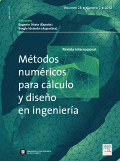
Revista Internacional de Metodos Numericos para Calculo y Diseno en Ingenieria
Empowering Innovation in Applied Mathematics and EngineeringRevista Internacional de Metodos Numericos para Calculo y Diseno en Ingenieria is a prominent academic journal dedicated to the dissemination of innovative research and methodologies in the fields of applied mathematics and engineering. Published by SCIPEDIA S L in Spain, this journal has been an essential resource for researchers since its inception in 1987, transitioning to an Open Access model in 2016 to enhance accessibility and foster collaboration among professionals and academics globally. Currently indexed in Scopus, it holds a Q4 category designation in both applied mathematics and miscellaneous engineering fields for 2023, reflecting its focus on advancing numerical methods to solve engineering problems. Despite ranking at the lower percentile, it serves as a vital platform for emerging scholars and practitioners aiming to contribute to cutting-edge developments in numerical techniques and engineering design. The journal's commitment to providing a forum for new ideas makes it an invaluable asset for students, researchers, and industry professionals seeking to stay abreast of advancements in the discipline.

ARCHIVES OF MECHANICS
Unleashing Innovation in Mechanical Engineering and Materials ScienceArchives of Mechanics, published by the Polish Academy of Sciences Institute of Fundamental Technological Research, is a distinguished open-access journal established in 1971 that has played a pivotal role in the dissemination of knowledge in the fields of Mechanical Engineering and Condensed Matter Physics. With its commitment to accessibility since adopting open access in 2022, this journal provides a platform for researchers, professionals, and students to share cutting-edge research findings and innovative methodologies. Although it currently holds a Q4 ranking in Condensed Matter Physics and a Q3 ranking in Mechanical Engineering for 2023, its comprehensive scope, which spans critical advancements in mechanical systems and materials science, positions it as a valuable resource for the academic community. Located in Warsaw, Poland, the journal continues to contribute significantly to the global discourse on mechanics and is dedicated to fostering new ideas that advance both theoretical and applied aspects of the discipline.

ACTA MECHANICA
Catalyzing Research for Tomorrow's TechnologiesACTA MECHANICA, published by Springer Wien, is a reputable journal that has been an integral part of the fields of Computational Mechanics and Mechanical Engineering since its inception in 1965. With a strong emphasis on innovative research and advanced methodologies, the journal has established itself in the academic community, currently holding a distinguished Q2 ranking in both categories for 2023. The journal’s ISSN is 0001-5970, with an E-ISSN of 1619-6937. Furthermore, it proudly ranks #26 out of 89 in Computational Mechanics and #217 out of 672 in Mechanical Engineering in the Scopus database, placing it in the top percentiles of its respective fields. Researchers, professionals, and students can access cutting-edge articles that cover a wide range of topics, contributing significantly to ongoing dialogues and discoveries within mechanical disciplines. Though not an open-access journal, ACTA MECHANICA offers a platform for highly qualified researchers to disseminate their work, ensuring that significant findings advance the field's boundaries. For more information, visit the journal’s address at Prinz-Eugen-Strasse 8-10, A-1040 Vienna, AUSTRIA.

Moscow University Mechanics Bulletin
Navigating the Future of Engineering and MechanicsMoscow University Mechanics Bulletin, published by PLEIADES PUBLISHING INC, is a dedicated journal that has been influencing the fields of mechanical engineering and mechanics since its inception. With an ISSN of 0027-1330 and E-ISSN of 1934-8452, this journal serves as a crucial platform for advancing knowledge in mathematics, mechanical engineering, and mechanics of materials. Though currently indexed in the Q4 category across these disciplines, it offers a unique space for researchers and professionals to engage with emerging theories, experimental results, and practical applications. With a converged publication history spanning from 1973 to 1987, and continuing from 2007 to 2024, the journal remains relevant in today’s academic landscape. Though it operates under traditional access models, the journal's global reach aims to connect diverse voices in engineering research. Aspiring researchers and seasoned professionals alike will find valuable insights and a robust discourse that contribute to their respective fields.
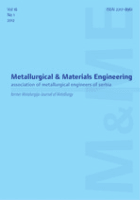
Metallurgical & Materials Engineering
Empowering discoveries in metallurgy and alloys.Metallurgical & Materials Engineering, published by Netherlands Press, is a prominent open access journal that has been advancing the field of metallurgical sciences and materials engineering since 2012. With an ISSN of 2217-8961 and an E-ISSN of 2812-9105, this journal provides a vital platform for researchers, professionals, and students to disseminate and access high-quality peer-reviewed research. As of 2023, it holds a Q4 quartile ranking in Mechanical Engineering and a Q3 ranking in Metals and Alloys, according to Scopus. This reflects its ongoing commitment to high standards despite being in a competitive sector. The journal covers a wide array of topics within the scope of materials science, with a focus on metallurgy and alloy technologies, and serves as a crucial resource for those engaged in innovative material development and application. Offering an open-access model emphasizes its dedication to making research widely available, thereby fostering collaboration and advancement in the materials engineering community. Join us in contributing to a dynamic and essential field of study.

Composites-Mechanics Computations Applications
Innovating the intersection of theory and application in composites.Composites-Mechanics Computations Applications is a pioneering journal published by BEGELL HOUSE INC, dedicated to advancing the field of composite materials and mechanics. With an ISSN of 2152-2057 and an E-ISSN of 2152-2073, this journal serves as a vital resource for researchers, professionals, and students seeking to explore the latest advancements in composite materials, computational mechanics, and their applications across various industries. Although it currently resides in the Q4 category for both ceramics and composites, as well as mechanics of materials, it provides a platform for quality research that highlights emerging trends and innovations. The journal, operational from 2010 to 2024, encourages submissions that cover theoretical, experimental, and computational methodologies, aiming to bridge the gap between practical applications and theoretical advancements. While the journal does not offer open access, it remains an important source for insightful studies that contribute to the evolving disciplines of materials science and engineering.

FDMP-Fluid Dynamics & Materials Processing
Bridging Fluid Dynamics with Material Processing ExcellenceFDMP-Fluid Dynamics & Materials Processing, published by TECH SCIENCE PRESS, stands as a significant contribution to the field of materials science, specifically focusing on the intricate relationships between fluid dynamics and material processing. With an ISSN of 1555-256X and an E-ISSN of 1555-2578, this journal offers an open-access platform where researchers can disseminate their work broadly, promoting collaboration and innovation among professionals and students alike. Established in 2007 and continuously evolving through to 2024, the journal is classified in the Q4 category of materials science, ranking at #347 out of 463 in the Scopus database, signifying its niche yet crucial role in the academic community. By focusing on the dynamic interplay between fluid behavior and material properties, FDMP addresses contemporary challenges and advances in material processing techniques. The journal plays a pivotal role for academics and industry professionals seeking to push the boundaries of knowledge and application in materials science.
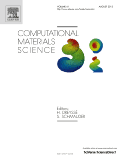
COMPUTATIONAL MATERIALS SCIENCE
Transforming Ideas into Material SolutionsCOMPUTATIONAL MATERIALS SCIENCE is a prestigious academic journal dedicated to the dissemination of innovative research in the field of computational materials science, emphasizing the interplay between computational methodologies and materials engineering. Published by ELSEVIER in the Netherlands, this journal showcases high-impact articles that contribute significantly to the understanding of material properties through computational techniques. As evidenced by its 2023 Scopus Rankings, which place it in the top quartiles across multiple disciplines including Computer Science, Materials Science, and Physics and Astronomy, it is a vital resource for researchers, professionals, and students alike. With a focus on advancing scientific knowledge and practical applications, COMPUTATIONAL MATERIALS SCIENCE aims to bridge the gap between theoretical investigations and experimental validation. Explore a wealth of cutting-edge research designed to inspire the next generation of innovations in materials science through this esteemed publication.
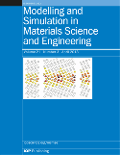
MODELLING AND SIMULATION IN MATERIALS SCIENCE AND ENGINEERING
Pioneering Insights in Materials ScienceMODELLING AND SIMULATION IN MATERIALS SCIENCE AND ENGINEERING, published by IOP Publishing Ltd, serves as a vital resource for researchers, professionals, and students engaged in the multifaceted fields of materials science, condensed matter physics, and computational mechanics. Since its inception in 1992, this journal has been committed to advancing knowledge through high-quality research articles, reviews, and simulations that explore complex interactions within materials. With an impressive Scopus rank in multiple categories, including Q2 in Materials Science and Mechanics of Materials, it reflects its significant influence and relevance in the academic community. Though not an open-access journal, it provides critical insights and developments in modeling techniques and simulations aimed at improving material performance and understanding thermodynamic processes, making it an essential read for those at the forefront of materials innovation. As it continues to expand its scope and reach into 2024 and beyond, MODELLING AND SIMULATION IN MATERIALS SCIENCE AND ENGINEERING remains a key platform for disseminating groundbreaking research that shapes the future of the discipline.